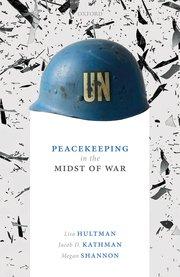Book: Peacekeeping in the Midst of War
Winner, Best Book in 2018/19 by the Conflict Processes section of the American Political Science Association. Discussed in a H-Diplo/ISSF roundtable and reviewed in International Peacekeeping.

Civil wars have caused tremendous human suffering in the last century, and the United Nations is often asked to send peacekeepers to stop ongoing violence. Yet despite being the most visible tool of international intervention, policymakers and scholars have little systematic knowledge about how well peacekeeping works. Peacekeeping in the Midst of War offers the most comprehensive analyses of peacekeeping on civil war violence to date. With unique data on different types of violence in civil wars around the world, Peacekeeping in the Midst of War offers a rigorous understanding of UN intervention by analyzing wars with and without UN peacekeeping efforts. It also directly measures the strength of UN missions in personnel capacity and constitution. Using large-n quantitative analyses and two case illustrations, the book finds that UN peacekeeping missions with appropriately constituted force capacities mitigate violence in civil wars. By analyzing the broader context of UN intervention effectiveness, the book concludes that peacekeeping is an effective way to reduce the human suffering associated with civil war.

